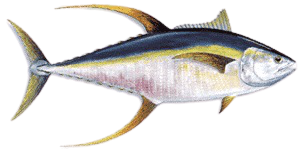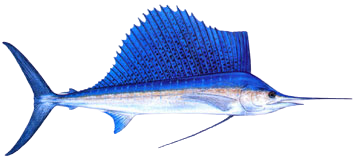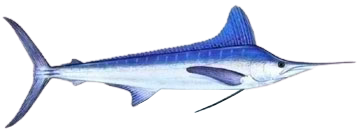Virginia Beach Sport Fish
As you can see when it comes to Virginia Beach sport fishing there are many great big game species including big billfish. When you make the trip to Virginia Beach for your fishing vacation you will certainly have a chance at catching one or more of these pictured species. So check out the fish, book your charter vacation, and get ready to hook up with one of these magnificent sea creatures on your next Virginia Beach fishing trip.
Dolphin
Other Names: Mahi Mahi, Dolphinfish,

Dorado Physical description:
The body of the dolphin is quite slender but fairly deep, with a noticeable tapering from head to tail. The male of the species is distinguished from the female by its high, vertical head. The anal fin has approximately 30 soft rays and stretches over half of the length of the body. The distinctive dorsal fin is long, covering almost three-fourths of the body, and has around 60 soft rays. The caudal fin is deeply forked and contains no spines. -- A blaze of blue and yellow or deep green and yellow when in the water, and sometimes shows dark vertical stripes as well when excited. Small dark spots on sides. Dorsal fin extends nearly from head to tail. Head is very blunt in males (bulls); rounded in females (cows).
Range:
While the greatest concentrations of dolphin are believed to be in the Indian Ocean and the western Pacific, they are found worldwide in tropical and subtropical waters and warmwater currents. All offshore waters of Virginia, the Bahamas and the Caribbean.
Feeding Habits:
Dolphin are known as voracious predators. While their favorite prey is the flying fish, they also consume squid, shrimp, crustaceans and even smaller dolphin. Using a keen sense of eyesight the dolphin locates most food near clumps of floating vegetation and objects.
Sporting Qualities:
The dolphin is considered one of the top offshore game fish and is highly targeted by anglers around the world. It is famous for its leaps and flips over the surface when hooked. Because of their speed and agility, dolphin provide for an exciting catch as they run long and jump often.
Habitat:
Dolphin are a warm-water fish usually found in deep waters, close to the surface. While sometimes found in coastal waters, they often concentrate in the open ocean around floating objects such as buoys, driftwood and seaweed clusters. They are considered to be the most surface-oriented of all big-game fish.
Wahoo
Other Names: Peto, Ono Physical description:
Long, slender body marked with zebra-like stripes of white and deep blue or black. Mouth is elongated and narrow, and equipped with razor-sharp teeth. Range:
Wahoo are present in the Atlantic, Pacific and Indian Oceans in clear, tropical and subtropical waters. Heavy seasonal concentrations occur off the Pacific coasts of Panama, Costa Rica and Baja California in the summer. Offshore of all Virginia coasts, especially the Keys, but for more plentiful in the Bahamas and many Caribbean Islands.
Feeding Habits:
While the wahoo is perfectly capable of biting chunks out of large fish, it primarily feeds on whole small fishes, such as sardines, scads, mackerel and squid. They are frequently solitary feeders, but they may sometimes be found in small, loose groups. Wahoo are sub-surface hunters that hang several feet below the surface and shoot up to attack prey with tremendous speed. Although they feed at all times, they tend to be more active in the morning and evening hours.
Sporting Qualities:
May strike a surface bait in spectacular, greyhounding fashion, but seldom jumps after being hooked. Wild fight is characterized by several sizzling runs, usually at or near the surface. One of the fastest of all gamefish.
Habitat:
Roams the deep blue water, but anglers can find them by working dropoffs, seamounts, weedlines and other favorable feeding locations.
Yellowfin Tuna
Other Names: Thunnus Albacares - (scientific Name)

Physical description:
Yellowfin tuna have a muscular, streamlined body like a swimming torpedo and like all tuna they can swim fast as lightning. A tuna’s color is dark blue to black on the back and tail fin, yellow and silver on the side and belly. The second dorsal and anal fins are yellow and very long in older fish. Finlets run down the back and belly from these two fins to the tail fin and are a bright, canary yellow with black edges.
Range:
Yellowfin tuna are found worldwide in tropical and some subtropical waters. These bodies of water include all three warm oceans Pacific, Atlantic, and Indian oceans and all warm seas except the Mediterranean.
Feeding Habits:
various baitfish, crustaceans and squids make up the bulk of their diet. They will hit chunks of cut up fish, (called chunking). Drift near a school, cut up your bait fish into halves and use for chumming while you place a fish head or half a fish on your hook. Toss out your line, no lead, and work it back into the chum pieces you throw over the side. A tune may hit the bait right near the surface. The feed most often at or near the surface and are often active at night.
Sporting Qualities:
Yellowfin tuna are considered an excellent food and sport fish and are highly sought after by anglers and commercial fishermen alike. After hitting a lure or bait, they often go deep and will fight with great power and tenacity.
Habitat:
Though they can withstand cooler water, yellowfin tuna prefer warm water and are found mainly in waters between 62 and 80 F. Yellowfin tuna, particularly young fish, usually school below the surface but over deep water, often several hundred feet. They avoid depths because of their intolerance for low concentrations of oxygen.
Atlantic Sailfish
Other Names: Spindlebeak, Pez Vela

Physical description:
The Atlantic sailfish’s most prominent feature is their first, sail-like dorsal fin, commonly referred to as its “sail dorsal.” Coloration of the body is dark blue to dark blue-green on top, brown-blue on the sides fading to silver-white underneath. The upper body has light and dark blue spots scattered about, while the sides have blue-gray vertical stripes that are often broken. The body of an Atlantic sailfish is slender and they are extremely fast swimmers, having the ability to swim at speeds up to 60 miles per hour. There is an obvious lateral line that runs over the pectoral fin and back along the flanks. The body is covered with embedded scales that become less numerous and more variable in shape as the fish ages.
Range:
Atlantic sailfish migrate extensively throughout the tropical and temperate waters of the Atlantic Ocean. The full range is from about 40 degrees north to 40 degrees south latitude in the western Atlantic, roughly from Maine to Venezuela. They are found throughout the Gulf of Mexico and Caribbean. Feeding
Habits:
Favored feeding areas are near schools of baitfish in areas where there is a temperature change. They may form small groups of 3 to 30 members that forage together. It is possible that, like the Pacific sailfish, they may cooperate to capture their prey, using their fins to create a trap that prevents fish from escaping and taking turns to feed. They attack prey with their fins and spear and then consume the stunned fish headfirst. Their favored food is other fish, including mackerel, tuna, herring, ballyhoo, needlefish and mullet.
Sporting Qualities:
A highly popular target for sportfishermen, especially off the coast of Virginia, Atlantic sailfish are a prized trophy species. Their popularity is a result of the challenge of catching one using light tackle, their penchant for dramatic leaps out of the water, and their stunning beauty. Due to declining numbers resulting from overfishing, most Atlantic sailfish are now caught and released, though this is not as common off the coast of Mexico and Central America. Habitat:
Although they traverse the vast ocean waters, Atlantic sailfish favor areas near the Gulf Stream current. They stay at mid-range to surface depths above the thermocline, in waters with temperatures between 70 and 85 F. Despite being caught on the surface, most of their feeding appears to occur in mid-level depths near areas with underwater structures. Compared to their Pacific counterpart, they usually stay in deeper water year round, going to depths as great as 600 feet.
Virginia Beach White Marlin fishing
White Marlin Other Names: Spikefish, Aguja Blanco

Physical description:
Similar in color to the Blue Marlin but proportionately lighter in body, white marlin can be distinguished from small Blues by the rounded tips of dorsal, anal and pectoral fins. Averages 40-70 pounds, 100-pounders not too uncommon; maximum less than 200. World record 181 pounds, 14 ounces; Virginia record 161 pounds.
Range:
Highly migratory, white marlin seek warm offshore waters in the Atlantic Ocean. They move from area to area in order to stay within temperatures from 68 and 84 F, which leads them to higher latitudes during summer and lower latitudes during winter. They are abundant in the temperate and subtropical areas of the Atlantic Ocean and Caribbean Sea.
Feeding Habits:
White marlin are aggressive, opportunistic feeders that seem willing to eat whatever is available in their environment. Their diet is likely dependent on their location and the availability of food sources. They seem to do most of their feeding during the day, feeding in both deep and shallow water, especially near underwater canyons, shoals and other areas with steep drop offs. Like other marlin, they use their long spear to stun their prey. The majority of their diet consists of fish such as herring, jacks, mackerels, triggerfish, dolphin fish and flying fish. However, squid and crabs can make up a significant portion of their diet.
Sporting Qualities:
White marlin are the most commonly encountered marlin along the Atlantic Coast of the United States and share the reputation of other marlin as a good-fighting trophy fish. They combine hard strikes on several natural baits and artificial lure with fast runs, deep dives and acrobatic jumps when hooked. This combination makes the fish a thrilling challenge on light tackle.
Habitat:
Preferring the deep, blue, temperate to tropical water above the ocean thermocline, white marlin normally roam the ocean at depths between 300 and 500 feet. They are well adapted to areas of low oxygen levels and high salinity. They also seem to congregate near currents with speeds between one and 3 miles per hour. While they are primarily deep-water fish, white marlin will frequently come into water as shallow as 50 feet, especially around debris or floating weeds. They sometimes travel in small schools of 5 to 12, especially when feeding on baitfish, but usually travel alone or in pairs.
Follow Us On Youtube
 Follow My Captain Jake Hiles Youtube channel, "Fishing with the Matador". I'm a professional fisherman from Virginia Beach, VA, USA, I own and operate Matador Charters and I travel all over the world fishing. I always have a line in the water working to create new video content. I have a very long resume with tournaments and records and this channel chronicles those accomplishments. I love God, my family, America, and FISHING!
Follow My Captain Jake Hiles Youtube channel, "Fishing with the Matador". I'm a professional fisherman from Virginia Beach, VA, USA, I own and operate Matador Charters and I travel all over the world fishing. I always have a line in the water working to create new video content. I have a very long resume with tournaments and records and this channel chronicles those accomplishments. I love God, my family, America, and FISHING!
Click SUBSCRIBE now for outdoors videos, fishing videos, how-to instructional fishing videos, and fishing related product reviews. My channel also has catch, clean, cook videos of freshwater and saltwater fishing for everything from largemouth and striped bass, giant tuna, marlin, sharks, and demonstrational fishing videos with tournament proven techniques to catch trophy fish


